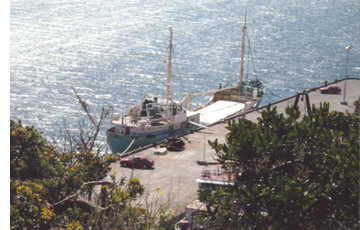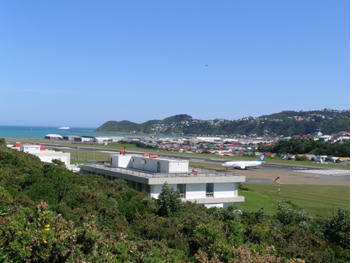Back in July I posted the first in this series of memoirs about my work on my book, “Researching THE FRODO FRANCHISE: Part I, Off to Wellington without a Handkerchief.” I’ve been all too long in following it up, but lots of travel, including attending the “Return of the Ring” event in England in August, has interfered. I’ve got at least a dozen of these entries planned, so despite the fact that so much attention is focused on The Hobbit, I’d better get going!
 This entry begins my recollections about the places where The Return of the King was still being worked on when I showed up at the end of September, 2003. They are scattered mostly around the Miramar peninsula, which was and is sometimes referred to as “Wellywood.” I gradually visited all of them to interview filmmakers or to get tours to familiarize me with the facilities that Peter Jackson and his colleagues had built up. That process had happened during the 1990s, but it accelerated to a breathless pace as the infrastructure for accomplishing the three parts of The Lord of the Rings were built and expanded.
This entry begins my recollections about the places where The Return of the King was still being worked on when I showed up at the end of September, 2003. They are scattered mostly around the Miramar peninsula, which was and is sometimes referred to as “Wellywood.” I gradually visited all of them to interview filmmakers or to get tours to familiarize me with the facilities that Peter Jackson and his colleagues had built up. That process had happened during the 1990s, but it accelerated to a breathless pace as the infrastructure for accomplishing the three parts of The Lord of the Rings were built and expanded.
Those facilities have grown even further as King Kong, Avatar, and now The Hobbit have been made. This is the story of how I discovered them in 2003 and 2004.
Three Foot Six
Last time I described how unit publicist Melissa Booth met with me and started arranging some interviews with filmmakers. The first of these was with Julie Alley, the merchandising coordinator. Her office was in the headquarters of Three Foot Six, so I headed there from my hotel, the Victoria Court Motor Lodge, on the morning of Tuesday, September 30, my second full day in Wellington.
Naturally, not knowing the public transportation system, I took a taxi. It’s about a fifteen-minute drive from the Victoria Court to Miramar, one that I got very used to and naturally very fond of. I often asked my taxi drivers about their opinions of The Lord of the Rings. Did they approve of government funding going to support the production? All but one of the taxi drivers I questioned in Wellington and elsewhere did approve. Most had an anecdote to tell about their own connection to the filming. One in Wellington had been hired to drive a forgotten prop out to a filming location in the Hutt Valley, that sort of thing.
On that first day, driving out along Cobham Drive, which skirts the southern shore of Evans Bay just north of the airport, the driver pointed out to me a small, old-looking ship moored at a wharf on the west coast of the Miramar Peninsula (above, right). He said that it was a big secret, but everyone knew this was the ship purchased for use in King Kong. Sure enough, later it was repainted and otherwise overhauled to “play” the ship in Peter’s next film. A year later I would see a beautifully detailed model of the ship when I toured the miniatures unit.
 A few minutes later we arrived at the Three Foot Six building. Unlike the other facilities in Miramar, this one was merely rented for the duration. It had been a pilots’ school. What it became after The Lord of the Rings was finished with it, I don’t know. It is located across the road from the airport.
A few minutes later we arrived at the Three Foot Six building. Unlike the other facilities in Miramar, this one was merely rented for the duration. It had been a pilots’ school. What it became after The Lord of the Rings was finished with it, I don’t know. It is located across the road from the airport.
That first day I had my interview with Judy, who proved incredibly knowledgeable about the dealings with licensees. She was the one in charge of supplying material to video-game designers and others making the many products associated with the films. She had previously been involved in the filmmaking itself, helping to create the fabric-based props like the banners decorating the walls in the hall at Edoras. (Judy was interviewed about the props for The Lord of the Rings Fan Club Official Movie Magazine. If you’re lucky enough to own a set of that invaluable publication, you can read the interview in issue #7.)
That day I got to see Three Foot Six’s lobby, which was no bigger than a dentist’s waiting room—though it was decorated with a small case containing awards won by the first two parts of The Lord of the Rings, including a BAFTA or two and a Golden Gandalf. After the interview Judy took me down to a small storeroom with some archives from the production, which she managed. (I gather that she was one of the few people whose memory was good enough to remember where the huge number of items related to the production was stored!) These included some beautiful drawings by Alan Lee and John Howe, as well as stacks and stacks of Polaroid photos taken on the sets after each day’s shoot. Judy explained that if retakes had to be made, sometimes many months later, such photos would allow the set dressers to place all the props in exactly the same places where they had been originally. Nowadays, of course, all those photos would be done digitally.
On later visits to Three Foot Six, I walked along long corridors to visit people in the far reaches of the building. There were many small offices along these corridors, with windows through which I could glimpse people working at computers, mixing sound for The Return of the King. Most of them seemed to be working on the Battle of the Pelennor, with muted roaring noises dimly audible and occasionally bursting forth when a door opened.
It was in this building that Barrie Osborne, my staunch supporter throughout my attempts to get my book researched and written, had his office. There he met at midday each day to plan various things associated with the production. Later, in the third week of my visit, I had an interview with Barrie scheduled and was waiting for him to get out of such a meeting. I noticed a package sitting on the receptionist’s desk, waiting to be picked up by FedEx. According to the customs form, it was a Gondorian helmet, headed for Electronic Arts in Los Angeles. I suppose it was destined to be scanned as part of the design for the upcoming video game. That was one of the elements Judy supplied to EA as a licensee. Two years later I would interview Nina Dobner of EA, who had been responsible for ordering that helmet and many other items for the design of the video games.
It was during that same wait that a young man came into the lobby and was greeted by Melissa. She introduced me to him. It was Michael Pellerin, the producer-director of the extraordinary making-of supplements for the extended-edition DVDs of The Lord of the Rings (and King Kong as well). I had intended to interview him at some point, but I had assumed that would happen at his home office in Los Angeles. We chatted for a while, and it turned out that he knew me already! He had read my husband’s and my introductory textbook, Film Art, when in film school. We quickly arranged for me to interview him right there at Three Foot Six a week later, and to follow him around for the afternoon as he talked to people who might feature as talking heads in the supplements for The Return of the King. (More about that in a later entry.)
Stone Street Studios
After my interview with Judy was over, she conducted me on a terrific tour of the Stone Street Studios. This complex is just over a ridge from the Three Foot Six office building and hence also, quite famously, very near the airport. That ridge was a small version of the larger green zone on the ridges that surround much of Miramar. I took many a photo from those ridges, and especially this small one. These include all the photos in this entry.
The Stone Street Studios were as magical as a fan might imagine. In the large Studio A, with its big green screen, pickups were still in progress. Day after day, extras in orc costumes were being filmed. Later special effects would allow them to be added to shots in the Battle of the Pellenor fields. The orcs I watched being filmed were added to the close view of Grond being battered against the great gate of Minas Tirith. As we exited Studio A, I spotted the Grond miniature, perhaps seven or eight feet long, standing in an annex. That was the only one of the LOTR “bigatures” I ever had the privilege of seeing.
We also toured Studios B and C. Some of the set elements from the pick-ups were still sitting around, notably the statue from Rivendell that holds the shards of Narsil (which apparently will feature in The Hobbit as well) and the White Tree, with its blossoms as they appear in the coronation scene. Judy also took me through the make-up area and the costume storage room. The costumes from pick-ups were still there, including all the versions of Gandalf’s and Gimli’s costumes for the various scale players.
Judy saved the best for last, though. We went to the art department, and I met Chris Hennah, who manages that department. (Later I was able to interview her and husband Dan Hennah, familiar to all as the art director of The Lord of the Rings.) In the back was a huge warehouse full of props. There was a flat façade of a hobbit hole, barrels and chairs in various scales, Galadriel’s swan boat, Gandalf’s cart, and best of all, Théoden’s throne, which I got to touch. It’s a gorgeous piece of furniture, made of hardwood (oak?) and minutely hand-detailed and polished to a shiny surface. (I wish I could show pictures of all this, but of course using a camera inside any of the facilities was strictly forbidden.)
Later I had one more brief visit to Stone Street to see a little more filming of orcs, but apart from that, I had no access. Like, other visitors, I could only stand outside the gate or look down from the ridge. There I photographed the last standing set from The Lord of the Rings (below). A week before I was scheduled to leave, I stood on the same ridge and watched that set being torn apart. Men with sledge hammers whacked the facades (made, it looked like, of plywood and Styrofoam) off their scaffolding. Other men then tossed the pieces into trucks headed for the dump. It was a sad moment, of course, but one that made me glad I had made it to Wellington just in time to see this winding down of the production and to talk to the crew members still there.
I was planning to write about all the filmmaking facilities I visited in one entry, but there’s too much more to tell! The rest will have to wait until the next.



